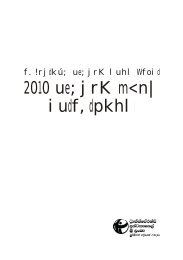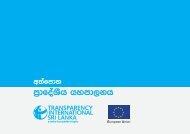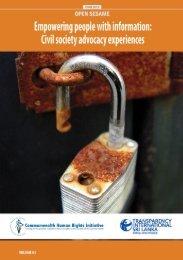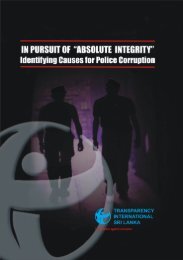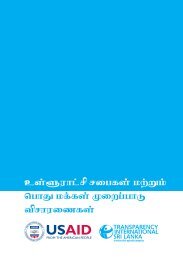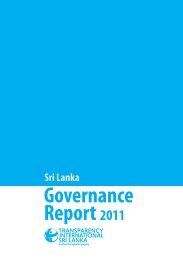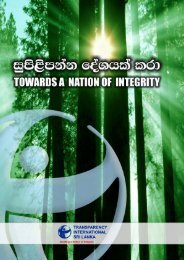Download Full Position Paper - Transparency International Sri Lanka
Download Full Position Paper - Transparency International Sri Lanka
Download Full Position Paper - Transparency International Sri Lanka
- No tags were found...
Create successful ePaper yourself
Turn your PDF publications into a flip-book with our unique Google optimized e-Paper software.
arise in having two examinations. Firstly, the DOEshould have ensured that a reasonably equal andsimilar level of difficulty was maintained for theidentical subject in both the New and Old Syllabiexamination papers. According to the findings andas it was accepted by the Court, 16 it was revealed thatthe given level of difficulties had been unreasonablydifferent which was an injustice to the candidates............. one of my two children sat for the exam in theold syllabus and the other sat for the new one. Theone who sat the old syllabus, got high ranks when theoriginal results were released, but had gone downtremendously when the results were given the nexttime. The one who did the new syllabus originally waslow on a low rank and had gone up this time..........- a participants of the ‘Sambhashana’, July 2012.Residual IssuesPublic TrustPublic trust is laid on the responsible behaviourof government institutions, commonly basedon transparency and accountability. Thus, thecandidates were not happy with the results receivedby them and there was criticism against the DOE. Thisis an important factor of trust concerning the results.According to the Minister of Higher Education, as at12.00 noon on 17 January 2012, there were 57,000 17candidates, out of 295,317 18 (approximately 19%)candidates who sat for the examination, madeapplications for re-correction of the results. This isan evidence of loss of trust of the results issued bythe Department of Examinations.University admissions are based on the result sheetsprepared after re-correction of answer scripts, anda one month period was given to students to applyfor re-correction. In 2009, changes were found in thegiven Z-Score after the re-correction in 1.28 percentof the total number of applications made.Solution birth of another problemIt is consoling to see that the crisis has been solvedby providing more opportunities to the distressedcandidates to proceed with higher education. But stillit is confusing why the UGC proposed four optionsto the Supreme Court to settle the matter, whileeveryone knew what the best option was. It appearsthat the UGC was reluctant to take a progressivedecision. Meanwhile, the loss of time, money, mentalstability and trust on the existing education systemare the negative factors that can never be recovered.Hence, it is vital that take immediate and necessaryaction is taken by the authorities to restore thepublic confidence and trust.University Entrance ExaminationThe whole education system today has been deviatedfrom a value-based and knowledge-based education,to a university admission-based education which isthe cause of the present drawback in the educationsystem. In order to move forward for a National FreeEducation System, it is high time to consider theGCE A/L as a qualifying examination, and not as aselection test for University education.Under the present circumstances, several questionsarise in the mind of an ordinary person: What isthe objective of the GCE A/L? Is it an examinationfor University entrance? If it is not meant for theselection for Universities, what is the best wayof selection? Is the Z-Score the most appropriateapproach in ensuring fairness in selection? Morethan all of these, the underlining factor is thetransparency and accountability of the educationadministration. Was the process transparent? Whois accountable for what?<strong>Transparency</strong> and AccountabilityThe lack of transparency and accountabilityshown during the crisis by the authoritarian andbureaucratic education administrators, includingboth Ministers was evident. This has two faces;one is failure to perform as required, and other isirresponsibility.As the former Dean, Faculty of Law, Universityof Colombo commented “.... I am in view that theUniversity Grants Commission should publishopenly every year its admission policy, criteriaadopted to select candidates, each candidate’s marksand ranking, ...... <strong>Transparency</strong> will not only makecandidates trust the institution and the decisionmaking process, but also cause the institute to beresponsible and accountable” 19 ....[emphasis added],transparency and accountability are two sides of acoin that are inter-linked and inter-related.Durable SolutionsFurthermore, issues as to what prompted theintroduction of the Z score, disparities in the facilitiesand resources available for teaching and learningin popular national schools and rural schools,inadequacy in the number of university admissionswith all those who pass A/L qualifying for highereducation have to be given due consideration. Afterall, state-sponsored education is a fundamentalcornerstone of the <strong>Sri</strong> <strong>Lanka</strong>n state structure.16. Ibid 2317. Parliamentary Deb 17 January 2012, vol 206, No.1, col 10118. Parliamentary Deb 17 January 2012, vol 206, No.1, col 7719. SC/FR 29/2012| 5
<strong>Position</strong> StatementAccording to the Directive Principles of State Policyand Fundamental Duties of the State, completeeradication of illiteracy and assurance to all personsof the right to equal access to education at all levelsis among the one of the principles that guides thelawmakers and the governance of <strong>Sri</strong> <strong>Lanka</strong>. 20 TheSupreme Court, in the case of Karunathilaka &another, V Jayalath de Silva, highlighted the value ofthe education quoting the following statement. 21“Education is a companion which nomisfortune can depress, no crime candestroy, no enemy can alienate, nodespotism can enslave. At home a friend,abroad an introduction, in solitude a solace,and in society an ornament. It chastens vice,it guides virtue, it gives at once, a gracegovernment to genius. Without it what isman? A splendid slave, reasoning savage” -Joseph Addison, in “The Spectator”Right to Education has been identified in most ofthe Universal Human Rights Instruments as a basicright. The Universal Declaration on Human Rights,in Article 26 stipulates that everyone has the rightto education; education shall be free, at least in theelementary and fundamental stages, elementaryeducation shall be compulsory. It also identifies thattechnical and professional education shall be madegenerally available and higher education shall beequally accessible to all on the basis of merit.Furthermore, the <strong>International</strong> Covenant onEconomic, Social and Cultural Rights of 1966(ICESCR), by Article 13 (1), while recognizingthe right of every one to education, Article 13 (2)itemises that the States have obligations to respect,protect and fulfil each of the “essential features”(availability, accessibility, acceptability, adaptability)of the right to education. 22By way of illustration, a State must respectthe availability of education by not closingprivate schools; protect the accessibility ofeducation by ensuring that third parties,including parents and employers, donot stop girls from going to school; fulfil(facilitate) the acceptability of educationby taking positive measures to ensurethat education is culturally appropriatefor minorities and indigenous people, andof good quality for all; fulfil (provide) theadaptability of education by designingand providing resources for curriculawhich reflect the contemporary needs ofstudents in a changing world; and fulfil(provide) the availability of education byactively developing a system of schools,including building classrooms, deliveringprogrammes, providing teaching materials,training teachers and paying themdomestically competitive salaries. 23Noting that the Education defines the parameters ofliberty, dignity and justice and is the path of socialdevelopment, <strong>Transparency</strong> <strong>International</strong> <strong>Sri</strong> <strong>Lanka</strong>[TISL] was keen not only to examine the Z-Scorecrisis 2011, but also the whole education systemand its accountability and transparency. TISL is ofthe view that,• the GCE A/L should be a final evaluation ofperformance of formal education,• there should be a separate fair and justifiableselection procedure for the University entrancedeveloped through a wide range of publicconsultation ensuring the active participation of theeducation administrators, educationalists, expertson Testing and Evaluation, academics, professionalsand students,• a fair and justifiable selection process could beguaranteed only by providing of adequate andensuring equitable distribution of human andphysical resources among all schools,• the state needs to take appropriate action toaccommodate and/ or facilitate all those who areeligible for university entrance, and• swift action should be taken to develop a nationalpolicy on higher education.Further, TISL believes that the Z- Score crisis 2011was born and has lived long due to the lack oftransparency and accountability of the relevantauthorities. The accountability process needsto begin, when the Commissioner-General ofExaminations announces the holding of the GCE A/Lexamination. Simultaneously the selection criteriafor universities and the required average level ofmarks for different degree programmes shouldbe made available to ensure transparency andaccountability.-end-20. Directive Principles of State Policy and Fundamental Duties of the Constitution.Article27(2) (h), Constitution of <strong>Sri</strong> <strong>Lanka</strong>21. Karunathilaka & another V Jayalath de Silva. 2003 1 SLR 3522. General Comment on its implementation of Article 13, E/C.12/1999/10,CESCR General Comment 13, 8 December 199923. Ibid226 | <strong>Transparency</strong> <strong>International</strong> <strong>Sri</strong> <strong>Lanka</strong>




